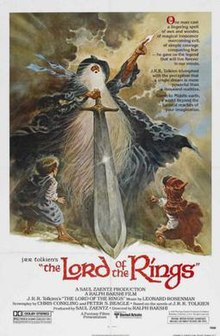
Back سيد الخواتم (فيلم 1978) Arabic Уладар пярсьцёнкаў (мультфільм) BE-X-OLD Властелинът на пръстените (филм, 1978) Bulgarian El Senyor dels Anells (pel·lícula de 1978) Catalan Der Herr der Ringe (1978) German Ο Άρχοντας των Δαχτυλιδιών (ταινία, 1978) Greek El Señor de los Anillos (película de 1978) Spanish ارباب حلقهها (فیلم ۱۹۷۸) Persian Taru sormusten herrasta (animaatioelokuva) Finnish Le Seigneur des anneaux (film, 1978) French
| The Lord of the Rings | |
|---|---|
 | |
| Directed by | Ralph Bakshi |
| Screenplay by | |
| Based on | The Lord of the Rings by J. R. R. Tolkien |
| Produced by | Saul Zaentz |
| Starring | |
| Cinematography | Timothy Galfas |
| Edited by | Donald W. Ernst |
| Music by | Leonard Rosenman[2] |
Production companies |
|
| Distributed by | United Artists |
Release dates |
|
Running time | 133 minutes[3] |
| Countries |
|
| Language | English |
| Budget | $4 million[2] |
| Box office | $32.6 million[3][5] |
The Lord of the Rings is a 1978 animated epic fantasy film directed by Ralph Bakshi from a screenplay by Chris Conkling and Peter S. Beagle. It is based on the novel of the same name by J. R. R. Tolkien, adapting from the volumes The Fellowship of the Ring and The Two Towers.[6] Set in Middle-earth, the film follows a group of fantasy races—Hobbits, Men, an Elf, a Dwarf and a wizard—who form a fellowship to destroy a magical ring made by the Dark Lord Sauron, the main antagonist.
Bakshi encountered Tolkien's writing early in his career. He had made several attempts to produce The Lord of the Rings as an animated film before producer Saul Zaentz and distributor United Artists provided funding. The film is notable for its extensive use of rotoscoping, a technique in which scenes are first shot in live-action, then traced onto animation cels. It uses a hybrid of traditional cel animation and rotoscoped live-action footage.[7]
The Lord of the Rings was released in the United States on November 15, 1978, and in the United Kingdom on July 5, 1979. Although the film received mixed reviews from critics, and hostility from disappointed viewers who felt that it was incomplete, it was a financial success; there was no official sequel to cover the remainder of the story. However, the film has retained a cult following and was a major inspiration for New Zealand filmmaker Peter Jackson.
- ^ "A Tom Jung Lord of the Rings key art illustration for the one sheet poster". Bonham's. 2020. Archived from the original on July 12, 2021. Retrieved July 12, 2021.
- ^ a b Beck, Jerry (2005). "The Lord of the Rings". The Animated Movie Guide. Chicago Review Press. pp. 154–156. ISBN 978-1-55652-591-9. Archived from the original on October 2, 2015. Retrieved May 18, 2020.
- ^ a b "The Lord of the Rings". Box Office Mojo. Archived from the original on January 31, 2012. Retrieved January 27, 2012.
- ^ "The Lord of the Rings (1978)". BFI. Archived from the original on July 9, 2021. Retrieved July 2, 2021.
- ^ Cite error: The named reference
ukgwas invoked but never defined (see the help page). - ^ Gaslin, Glenn (November 21, 2001). "Ralph Bakshi's unfairly maligned Lord of the Rings". Slate. Archived from the original on January 5, 2013. Retrieved December 28, 2020.
- ^ Maçek, J. C. III (August 2, 2012). "'American Pop'... Matters: Ron Thompson, the Illustrated Man Unsung". PopMatters. Archived from the original on August 24, 2013. Retrieved December 28, 2020.